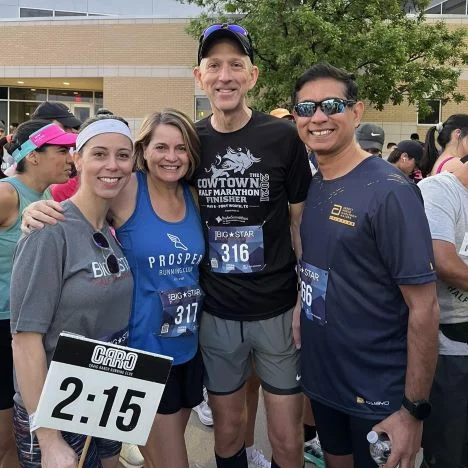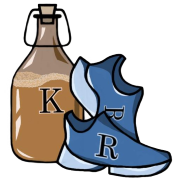On April 12, 2025, I toed the line at the Texas Big Star Half Marathon in Frisco, TX. This annual event, now in its 10th year, is organized by the Frisco Chamber Foundation and benefits local charities, including the Collin College Foundation. The race starts and finishes at Collin College’s Preston Ridge Campus and features a relatively flat course, making it a favorite among runners seeking personal bests. It was my first time running this local race—even after 12 years in the area—and my wife joined in too. While we didn’t run side by side, it was great to share the race experience. My goal? Break 1:45. I relied on Garmin’s adaptive training to get there and laced up my Nike Alphaflys on race day. Spoiler alert: I hit my goal, but the real story is in the details.
Packet Pickup & Pre-Race Scramble
Fleet Feet Frisco hosted packet pickup on Thursday and Friday before race day. I swung by Thursday, which was smooth and quick. While I was there, I realized my race fuel stash was down to a single Maurten gel—my go-to for long runs. I had to supplement with a leftover strawberry GU from the pantry. Lesson learned: inventory the gel drawer before packet pickup.
Training Plan: Garmin Adaptive – Smart but Soft?
For this race, I went with Garmin’s adaptive training, which adjusts workouts based on sleep, heart rate variability (HRV), and recovery status. It was convenient—especially with my unpredictable work schedule—but lacked some of the mileage and intensity I’d expect in a solid half marathon build-up.
My longest run? Just 8 miles, which felt light. I missed the structure and challenge of Garmin Coach, which includes longer runs and speedwork. More on that later.
Race Morning: Traffic Jams and Tree-Lined Solutions
We left at 6:00 a.m., thinking we had plenty of time for the 7:00 start. But traffic backed up badly heading into Collin College, where the race was staged. It took 20 frustrating minutes to crawl through the bottleneck. A few extra volunteers or officers directing traffic could’ve made a big difference.
We parked at 6:40 and walked about a half mile to the start—an unexpected but useful warm-up. The porta-potty lines were long, so I opted for the old runner’s trick: found a stand of trees. Not glamorous, but effective.
The Start: Running Club Energy and Smart Pacing

At the start line, I caught up with a couple of Prosper Running Club members. One was pacing the 2:15 group, and we took a few pre-race pics before lining up. I purposely started farther back in the corral, knowing I’d enjoy passing people along the way.
Once we were off, it took me about a minute to cross the timing mat. I avoided looking at my watch during the first mile to stay relaxed, especially with all the weaving through the pack. But when my watch buzzed for mile one—8:02. Right on track.
On the Course: Flow, Fuel, and Motivation
Conditions couldn’t have been better: sunny skies, temps in the 50s, and a nearly flat course with just 100 feet of elevation gain. I settled into a steady rhythm, clicking off miles around the 8-minute mark. A couple dipped into the 7:40s. I felt strong.
Around mile 8, I got a surprise jolt of motivation: a Prosper Running Club member was working the aid station, and we exchanged a high five. That quick moment of encouragement gave me a lift right when I needed it.
Later, I witnessed a fellow runner and dad pause to hug his kids as they cheered him on. When he caught back up to me, I told him, “That must’ve given you an extra boost.” He smiled and replied, “It always does,” before surging past me with renewed energy.
Race-Day Hack: The Alphafly Advantage
My Garmin had predicted a 1:51 finish, based on training in my regular shoes. But I had a secret weapon: my Nike Alphaflys, which reliably knock about 30 seconds per mile off my pace.
That math checked out. I trained at slower paces, but with the race-day shoes and adrenaline, my 1:45:28 finish landed nearly perfectly on goal.
Porta-Potty Pit Stop and the Paper Cup Plea
I made a quick pit stop around mile 10—a tactical decision. Trying to hold it was taking more mental energy than it was worth. The one-minute break helped, and I actually ran my fastest mile shortly after—recovered and recharged.
One gripe: most of the aid stations used rigid plastic cups. If you’ve ever tried drinking on the run, you know paper cups are easier to pinch into a funnel. Plastic ones? You can’t pinch them, and most of the water ends up on your shirt. A couple stations had paper cups (thank you!), but more would’ve helped.
Texas Big Star Half Marathon Finish and Aftermath
I crossed the finish line in 1:45:28, right where I wanted to be—even with the pit stop. My wife crushed it too—1:56 and third in her age group without much training. Super proud of her.
The post-race party was fantastic: Athletic Brewing was serving non-alcoholic beer, pancakes and syrup were flowing, and Emerald City Band brought the energy with a live set. We hung out, celebrated, and took it all in.
Post-Race Pain and Moving Forward
While the race went great, recovery was rough. My calves were tight even before the race, and post-race they were wrecked. I also noticed a flare-up of plantar fasciitis in my left foot (and some strange pain in my right). Just walking around that night was brutal.
Looking back, I blame the lack of mileage in training. Garmin’s adaptive plan kept me healthy, but didn’t build enough volume to leave me resilient. Next time, I’m going back to Garmin Coach—more structured long runs, more accountability, and hopefully less post-race hobbling.
Final Thoughts
Despite a few pain points—literal and logistical—this race delivered. It was well-organized, fun, and fast. And now that I know what to expect, I’m planning to come back stronger next year.
Pros and Cons of The Texas Big Star Half Marathon
Pros
✅ Flat, fast course
✅ Beautiful race day weather
✅ Great pacing groups and post-race celebration
✅ Seeing friends on course (and getting high fives!)
✅ Solid adaptive training insights
Cons
🚫 Parking traffic bottleneck
🚫 Rigid plastic cups at aid stations
🚫 Not a scenic route—mostly suburban roads
🚫 Limited long runs in training plan affected recovery

Leave a Reply
You must be logged in to post a comment.